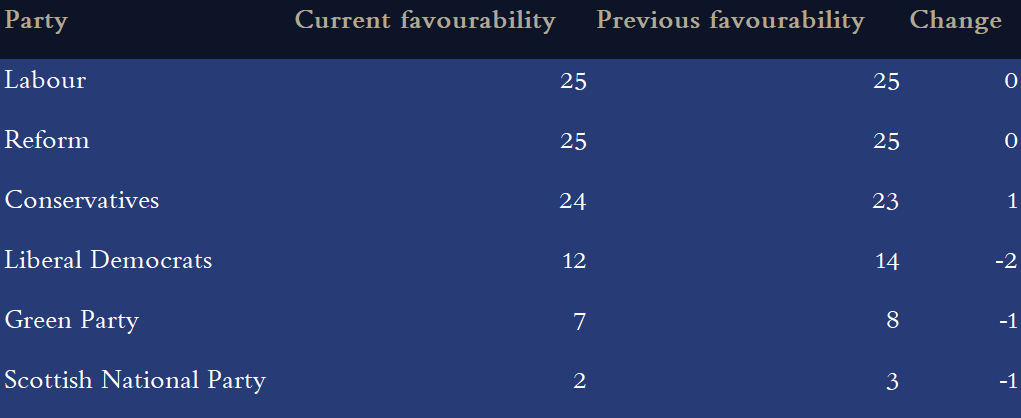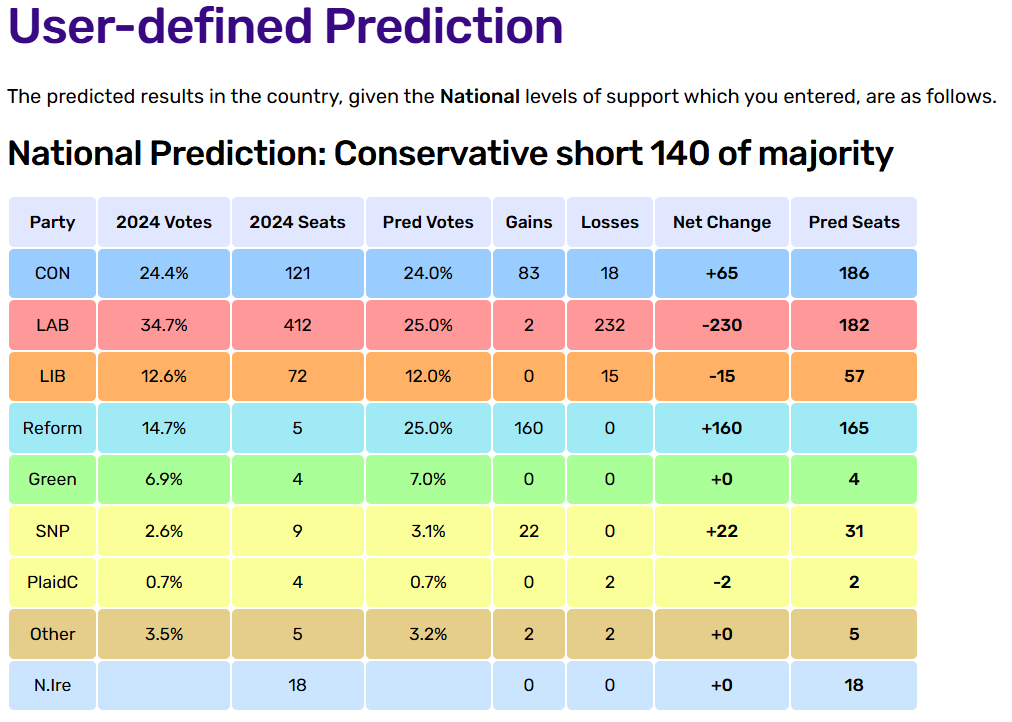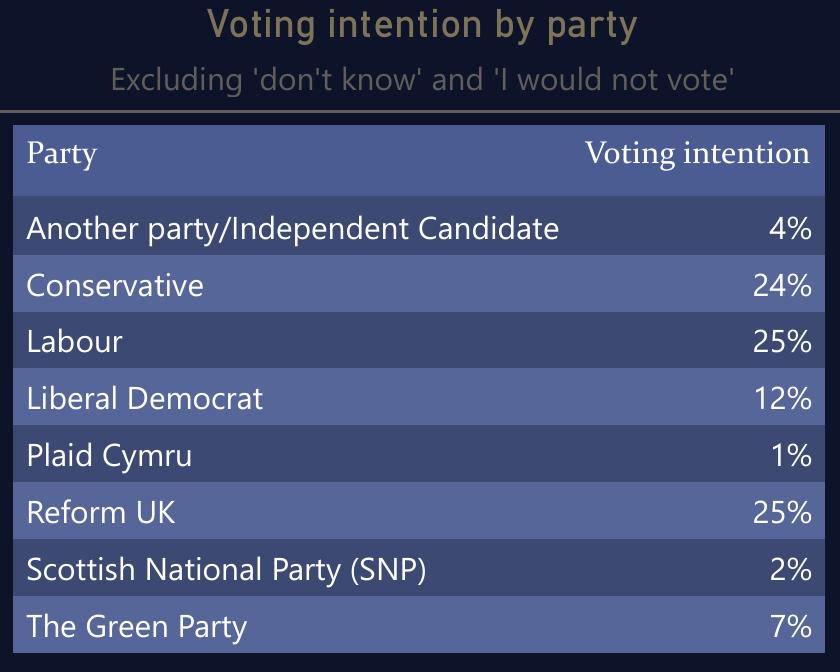Pollster: More in Common
Sample size: 2,432
Fieldwork dates: 14th-17th March 2025
Source
Headline stats
Compared to the previous week, Reform and Labour have stayed neck-and-neck, whilst the Conservatives have edged up marginally. Meanwhile, the Liberal Democrats and the Green Party have fallen slightly, as has the Scottish National Party.
If we plug this into Electoral Calculus, we see the following likely outcome:
This is based on excluding the ‘Don’t knows’ and the ‘I would not vote’, which is explored further below, but I think the most notable point in this poll is it brings the Conservatives, Lib Dems and Greens back to the percentages they achieved in the 2024 election (24, 12 and 7 respectively). This is positive for the Conservatives, in that it means they may well have overcome the turmoil of transition from one leader to another, and maybe - just maybe - are starting to regain credibility in the eyes of the electorate.
Of course, the ongoing and well-known story by now is the fact that Reform UK is tied with Labour. It would suggest that, by now, Reform has won over most of the wavering Conservative voters it can, and, if it continues to grow, this will be at Labour’s expense.
Detailed analysis
Of course, headline stats can distort the complexity of voting intentions. The headline stats above are based on excluding the ‘Don’t knows’ (DKs) and the ‘I would not votes’ (IWNVs). The breakdown, on this basis, looks like the following:
The first thing to note should be the ‘Another party’ option. It is impossible to say, without granular data, what those ‘other parties’ are, but given the emergence in the 2024 election of the Muslim Vote movement, as well as protest votes against the war in Gaza, one can assume that a healthy chunk of those votes would likely to go to such protest votes again. It should not set of alarms for any party at the national level, of course, but as Middle Eastern Eye pointed out and the party continues to be fearful of, there are Labour MPs at risk of losing their seats in constituencies with high concentrations of Muslim voters who are political active and capable of electoral mobilisation.
However, 2024 was important for other reasons as well. The foremost, but seemingly underdiscussed, is that 2024 was the second lowest turnout ever at 59.7%, very close to the lowest ever of 59.4% in 2001. For this reason, we need to be cautious over excluding the DKs and the IWNVs, because if they decide to stay home in the numbers they did in July, things could look very different.
Note that in this case, Reform at 24% would be the largest party by 2%, overtaking the Labour and Conservatives who would be tied on 22% while the Lib Dems, the Greens and the Other options all shrink, because the DKs alone make up 10%.
If this happens, the prediction from Electoral Calculus looks very different:
How different that result looks. Discounting the DKs and the IWNVs is a dangerous thing to do, because while it may produce more ‘accurate’ results when considering likelihood of voting (as More in Common does, and I think is reasonable to do so), it can be misleading in an era of apathy and lack of certainty.
Regional trends
Nevertheless, there are two interesting regional trends that can be pointed out:
Wales - As I suggested after the election, Reform has an opportunity to present itself as a Unionist alternative to the Conservatives, trading on disillusionment with Westminster and dissatisfaction with stasis in the devolved assemblies. This appears to be less true in Scotland, where the SNP has a long pedigree of governance, but in Wales there is a greater opportunity. Unfortunately MiC tends not to poll in Wales, so we can’t compare like-for-like in this case, but the most recent YouGov poll (from November…) suggests that Reform is breaking through significantly in Wales, polling at 23%, matching their national polling, just behind the nationalists Plaid Cymru (24%), and matching Labour on 23%. The regional success of Reform in Wales is both shifting the national model (see the image below) and suggesting that the ‘Celtic fringe’ discontent with Westminster is finally shifting away from separatism in favour of unionism, though clearly of a different kind.
Lib Dems and the semi-rural seats - The constituencies that sit on the margin between the urban centres and the truly rural seem to be where the Lib Dems are holding on the best, especially in the south. In fact, the model predicts that the Lib Dems would not lose any seats; whether this will be borne out is, of course, up for debate, but if that is true it speaks to the sheer level of mistrust the two main parties are facing even amongst the affluent middle class. If that class shrinks, however, the Lib Dems’ electoral prospects may change altogether.
Thank you for reading this short Poll Watch post, in which I look at and discuss the most recent public opinion survey. Please consider subscribing to and sharing this blog and, if you’re feeling particularly generous, subscribing to my paid content -(detailed research and policy proposals).










